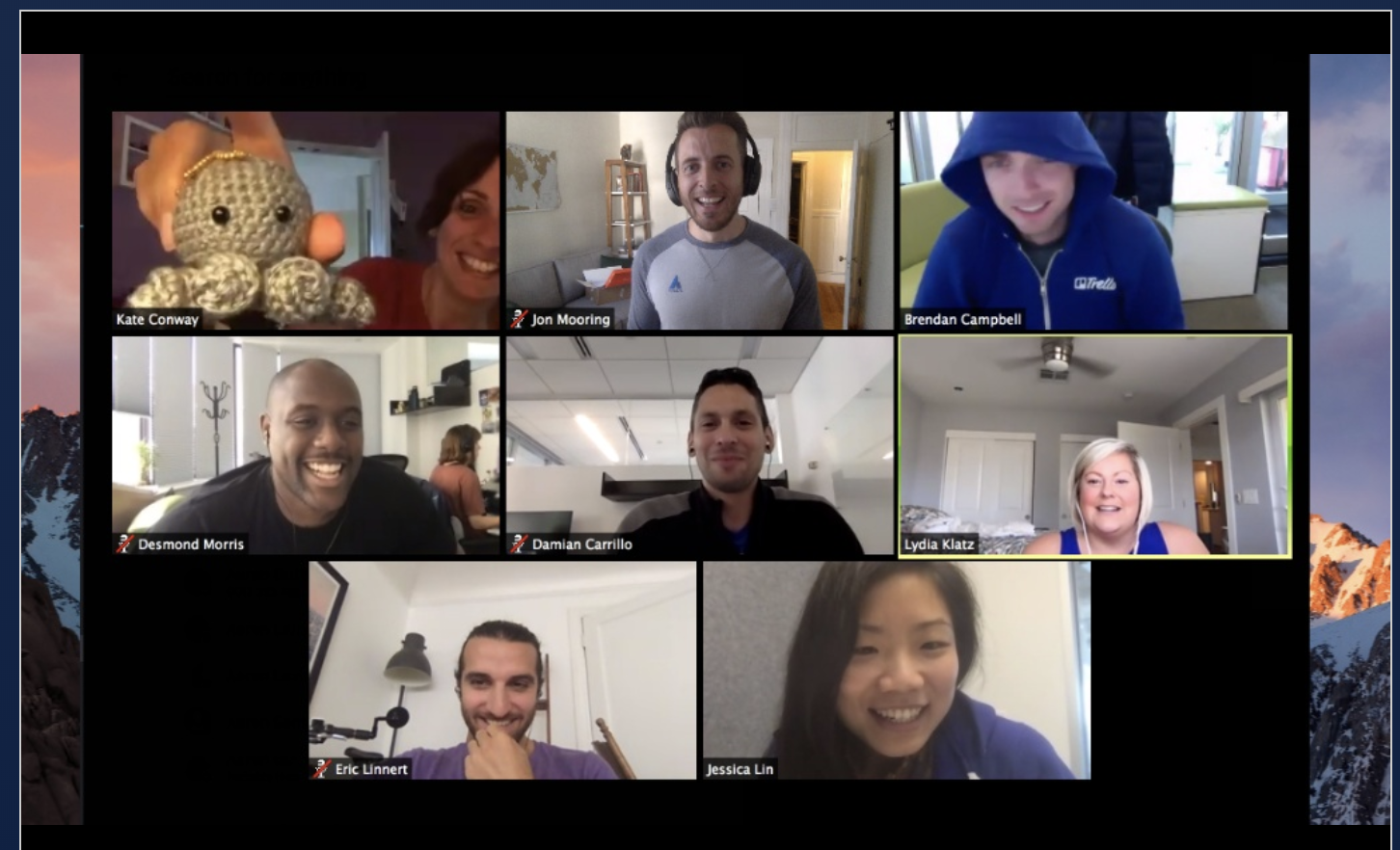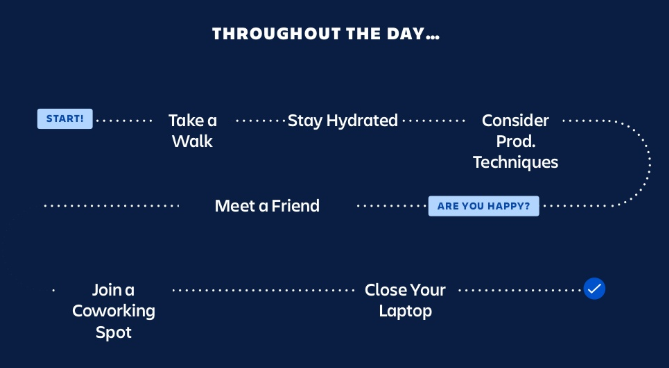Whether you’ve been working remotely for a decade (like me!) or are just getting started on your remote working journey, there are ways of making sure it’s a delight instead of a total drag.
In a recent survey, 77% of respondents reported greater productivity when working remotely compared to working in an office setting. In a different survey, 82% of respondents reported feeling happier when working remotely.
However, remote work is not all sunshine and yoga pants.
Some challenges of remote work include feelings of loneliness, isolation, and disconnection. In my Atlassian Summit talk, I shared over a decade of learnings from being a happy and productive remote worker. I truly believe that putting these learnings into place will help those working remotely for the first time—or for the fortieth time—be their best remote working selves.
What Is Remote Work?
I’m going to define remote work as “working from home (or wherever you choose) as a discipline.”
This means you’re treating remote work with an appropriate amount of respect and thoughtfulness at both an individual and at a team level.
You’re constantly trying to better yourself as a remote worker, and build a balanced remote culture within your team. The next most important thing is for your team to develop a shared context. A shared context means everyone is playing by the same rules, understands the team’s rituals and practices, and feels that they are operating in an equitable environment.
 A normal meeting at Trello. Some people are in offices, some people are working remotely. Can you tell?
A normal meeting at Trello. Some people are in offices, some people are working remotely. Can you tell?
Most people who work on Trello do so remotely. We decided to go down that road early on when we were a startup because remote work enabled us to hire the best people regardless of location, develop a results-oriented culture, and scale our processes digitally.
So how did we do it?
Let’s first explore what it really means to be a “remote worker” because that’s the first step to success.
Working From Home Does Not Equal Remote Work
In a lot of companies, “working from home” is synonymous with well, not really working.
One of the biggest misconceptions about remote work is that we’re all just sitting around in our yoga pants, binging Netflix, and doing our laundry. I think this comes from a mentality that, if you can’t see someone, how do you truly “know they are working?”
That’s got to be the first cultural myth to dispel in any organization that is really, sincerely willing to give remote work a fair chance. When remote work is your day-to-day reality, and not a wink wink nudge nudge exception, it becomes imperative to figure out the best ways to work.
This is a controversial stance to take, but I also sincerely believe that the whole “digital nomad” movement also does not represent remote work in its healthiest and most productive aspects.
Sure, I’d love to travel the world with my laptop and work from beaches in Thailand, but for the vast majority of remote workers who have to align on time zones, team communications, and have personal responsibilities outside of work, that’s just not going to work.
Now don’t pick up your pitchforks yet—I love to travel and think we spend too much of our lives working. I just don’t think the solution is to glob work and travel together. In this scenario, I don’t think you’re doing your best work or living your best travel life.
Some caveats: if you’re traveling for longer stretches of time where it’s not disruptive to your team and not changing time zones, you might be able to convince me otherwise. But probably not.
Trello’s Rules For Remote Work
We’ve developed a list of rules and practices that help maintain a shared context and help our team work together no matter where they are located.
1. Assume Remote
If even one person on your team is not in an office, assume remote. This means that you should take meetings from your desk and make sure to share all context of said meeting in a written format.
When the whole team is remote this is a moot point, but when you have a mix of people working remotely and in offices, it’s important to digitally share the same signals you would have in person..
2. Have A Dedicated Office Space With A Door That Closes
When you’re working remotely full time, it’s important to designate and optimize a workspace that is not your kitchen counter or living room couch. At Atlassian, remote workers are given a stipend for setting up their home office.
The door that closes is about making sure you’re creating the mental space to focus. This means having dedicated childcare when you’re working, just as you would if you were working in a traditional office environment.
3. Have The Tools To Do Your Job
Every team needs to use a defined digital toolset and every individual needs to have a strong internet connection. For example, we use Slack for chat, Trello for managing projects, Confluence for collaboration, Google Docs for sharing docs, and Zoom for all video meetings. Your toolset may be different, but defining it as a team is important for developing that shared context.
4. Communicate, Communicate, Communicate
Follow the Rule of Seven, which states that people need to hear a message seven times before they’ll internalize it. If you feel like you’re over-communicating information, you’re probably communicating just the right amount. Check out this presentation from a coworker who examines the medium of communications based on the audience and goal.
5. Schedule Face Time
Make sure your team has the opportunity to meet and bond in person. Having regular off-sites is key to fostering human relationships that make working remotely function better and more smoothly. I share how my team does this in this post. Use all that money you’re saving from costly office space and amenities to bring people together the old fashioned way.
6. Teams Must Have Time Overlap
For Trello, all teams must overlap from 12-4 PM EST. This creates a shared time that everyone is available to collaborate and/or meet. Time zones become much less of an issue if everyone is on the same page about when they’re available for collaboration, and they can use the remaining workday for other meetings or deep work.

Let’s Talk About Personal Productivity
With your team context in line and your workspace designated, now it’s time to think about how to change your usual habits to work in a remote environment. The most important part of personal productivity (remote or not) is time management.
Ask yourself: are you a maker or a manager?
Paul Graham has an amazing essay that has withstood the test of time about makers needing large swaths of focus time to do their work and managers being mostly in meetings. If makers have a manager’s schedule they’re likely going crazy and not getting any work done. If a manager has a maker’s schedule, they’ll feel useless and lonely. Now that we are mostly using digital calendars it’s easy to take a look at your calendar and make sure your schedule reflects your role.
I encourage the makers on my team to block hours of time as “focus time” and we even have designated “Maker Days” where people are discouraged from scheduling or attending meetings in order to get $#!* done (also known as GSD).
Here are some other pro time management tips:
- Set clear boundaries. Avoid blurring the lines between work and personal time. Set your notifications appropriately so you’re not responding to work emails while you’re playing with your kid in the park or committing to your meditation schedule. This is also why a dedicated office space is so important. At the end of the day, close the door and leave the work at work (or whenever you need to work next).
- Control your schedule. Structure your day and your calendar to optimize your own productivity. Block out time in your calendar to reflect your priorities.
- Optimize your environment. Some people need empty desks with just a few items to be productive, others’ desks reflect their messiness (erm creativity!). Many remote workers recommend having your desk near natural light and using plants like succulents to create a welcoming atmosphere. I’m a huge proponent of standing and walking desks to minimize sitting time. Show off your remote work set up by using the #WhereITrello on Instagram!
Are You Ready To Embrace Remote Work?
One of the best things about remote work is that you’re in charge of your own environment, so if something’s not working for you… you can change it!
I think it’s extremely important to develop strong self awareness as a remote worker. Some people are social creatures and need to be out and about to feel fulfilled. Folks like that may benefit from joining a co-working spot instead of working from home every day.
I’m guilty of being a hermit and forgetting to go outside, so I’ll schedule lunch or coffee breaks during the week to make sure I’m leaving the house.
Remote work doesn’t have to feel remote: it can be about being hyper-connected in an age of rapidly changing technology that makes it easy to do your life’s best work without being in the same place as your coworkers. Give it a shot and let us know what you think!









































